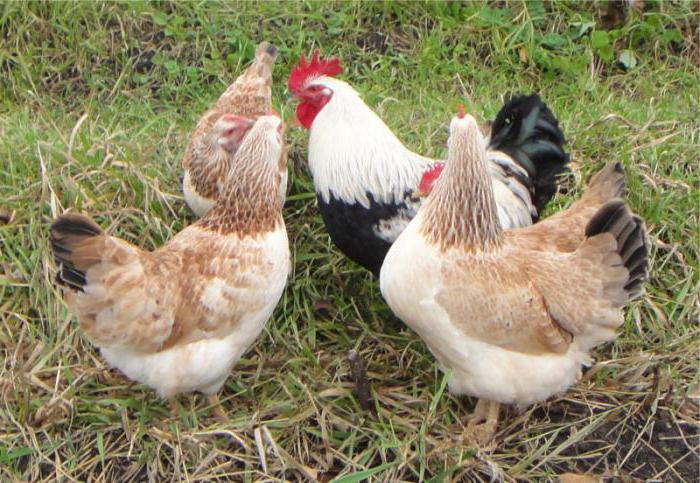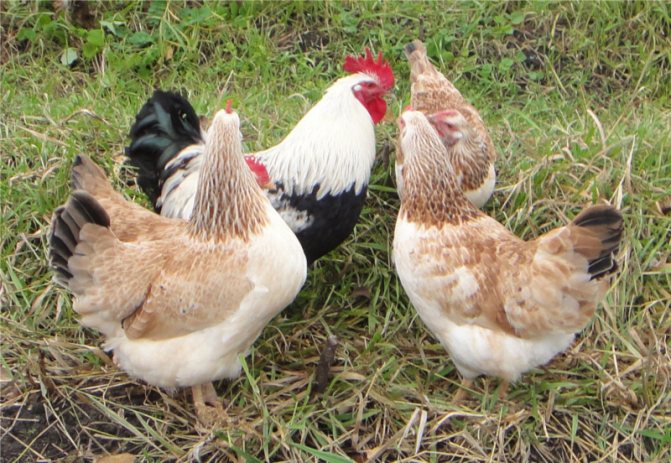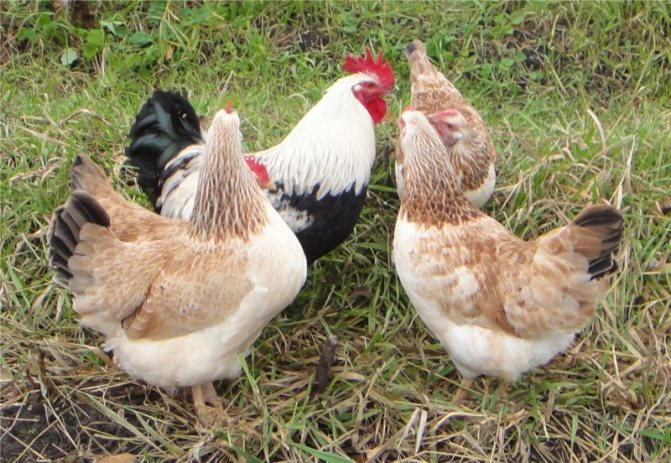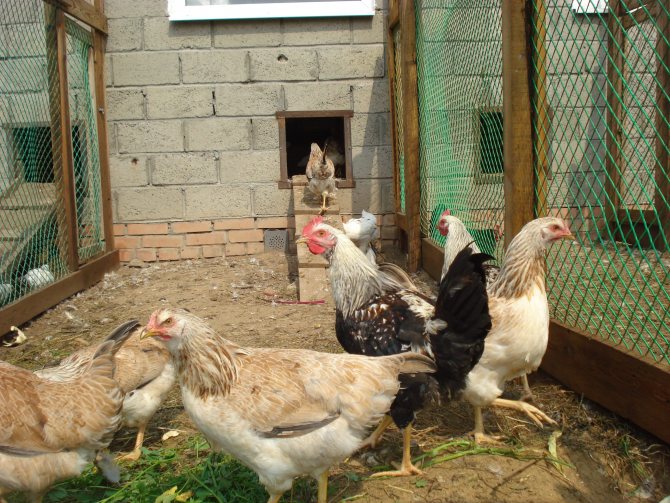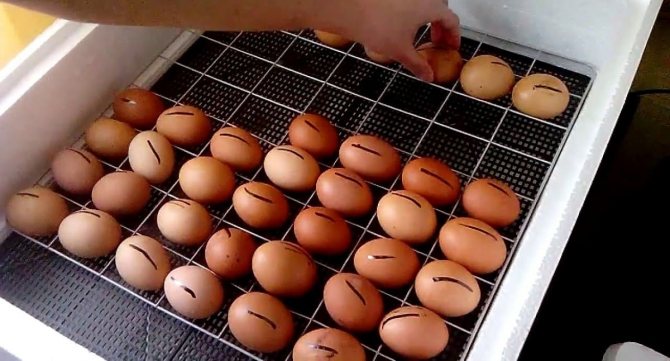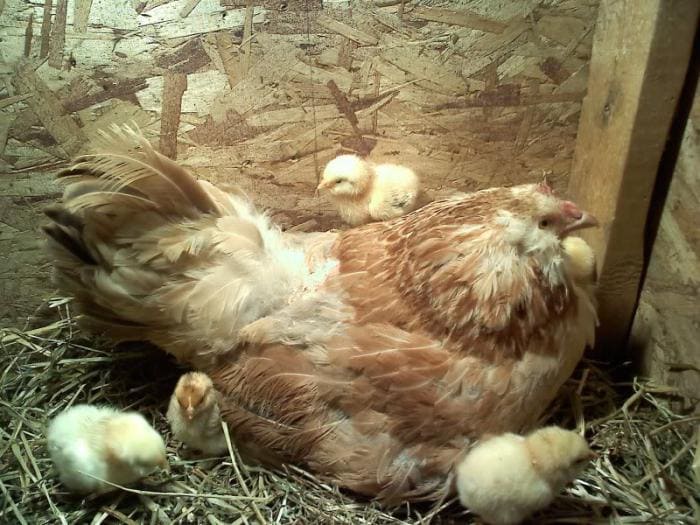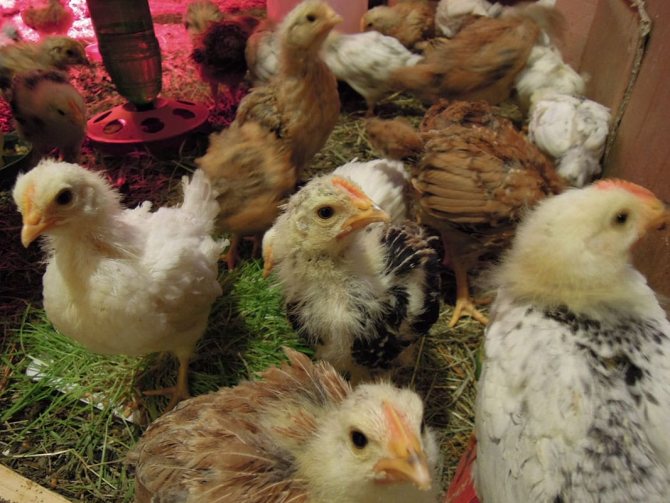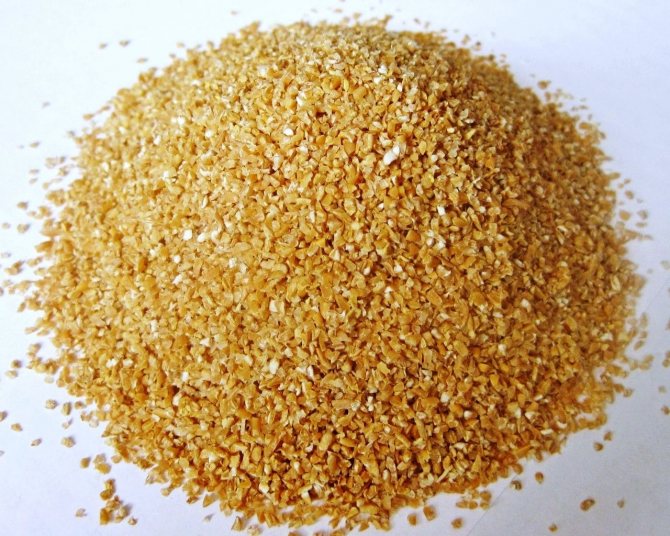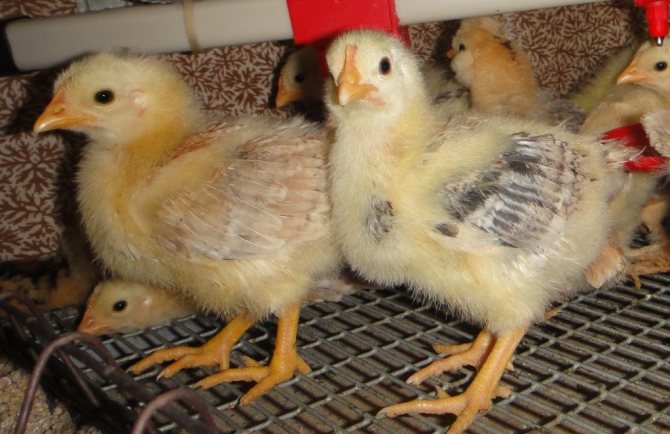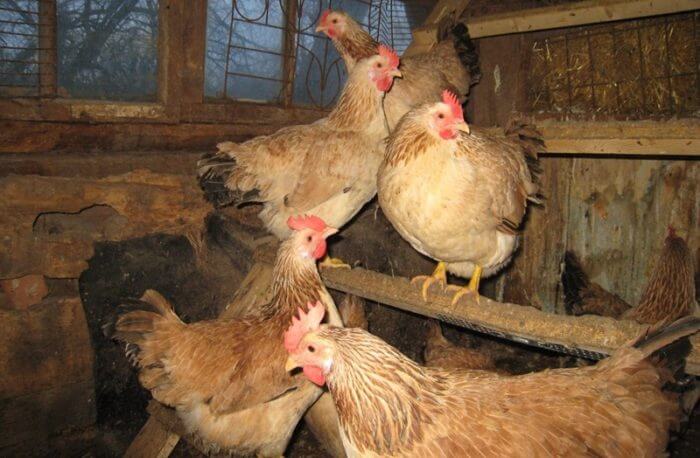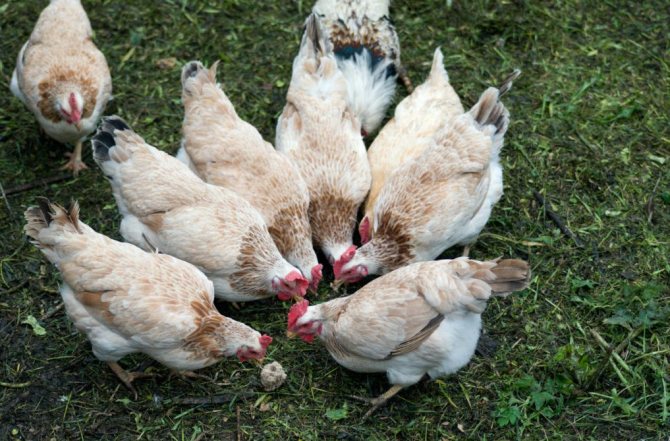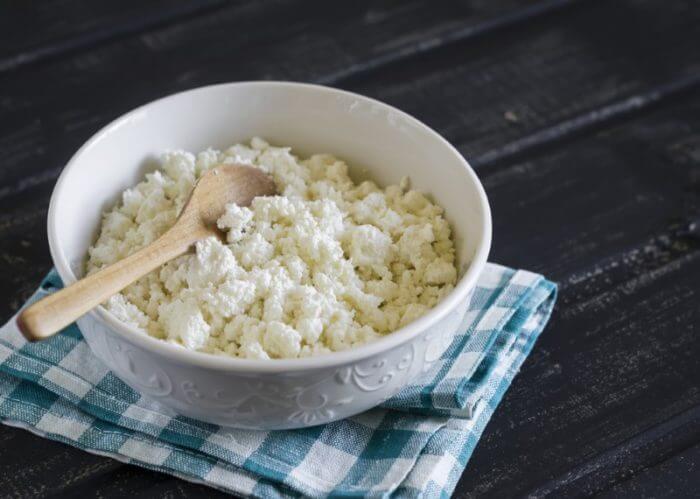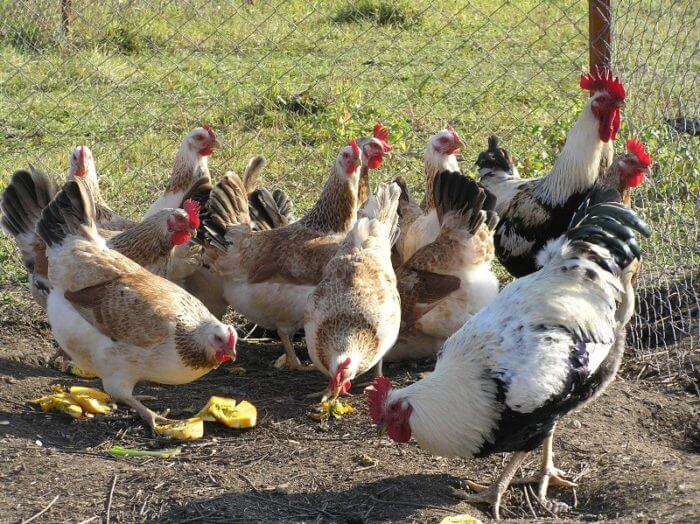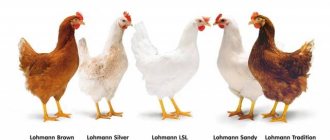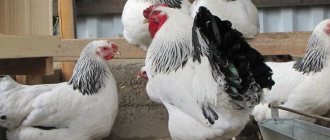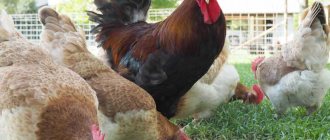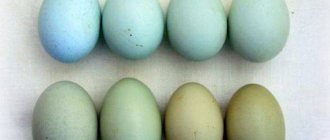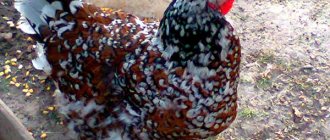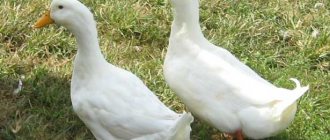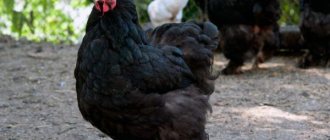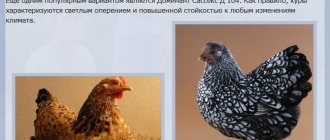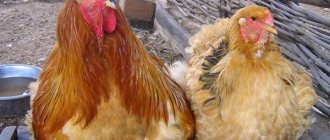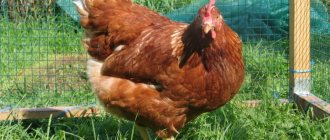The Zagorsk salmon breed of chickens is a very successful Soviet breed, ideal for the harsh conditions of Russia. A beginner who has decided to start poultry farming, but does not know which breed to choose, can safely recommend Zagorsk chickens.
Bred on the basis of crossing four breeds at the Institute of Poultry, located in the city of Sergiev Posad, this breed has become one of the most successful breeds of Soviet chickens. The name was given to it in honor of the old name of the city - Zagorsk.
Two Russian and two foreign breeds of chickens were involved in the creation of the breed: Yurlovskaya vociferous and Russian white; Rhode Island and New Hampshire.
From these breeds, the Zagorsk salmon chickens took all the best: cold resistance, unpretentiousness in food, egg production, rapid weight gain and endurance.
Description of the breed
Photo:
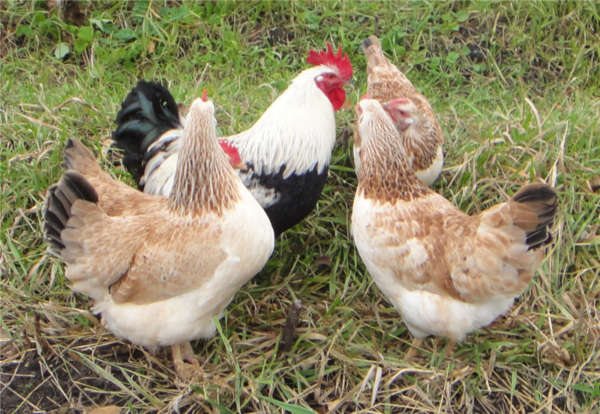
The second part to the name "salmon" breed received because of the beautiful salmon color. The description of the pets is as follows: chickens have light brown plumage with orange and pink tones, and roosters are tricolor (white, with yellow, and greenish-reddish tint).
The body of hens and roosters is large. The back is extended. At the base, the trunk expands. Males, which were bred at GNU VNIIGZH, are taller in their shins. The ones that Gene Pool bred are more stocky and squat. They have medium legs. Metatarsus yellow.
The leaf-shaped crest has 4 or 5 teeth. Breeders recommend leaving individuals with 5 teeth on the comb for breeding. It is bright red. The beard, with lobes, is also red.
The beak is yellow in color and has a medium size. If the rooster is dark, then at the beginning of the beak there may be dark spots. Females have lighter beaks with scallops.
Experts recommend rejecting from breeding those birds that have not 4 or 5 teeth on the comb, but different, if they have a dark beak or paws with a salmon color. Birds are removed from breeding, in which the color does not correspond to the breed.
Laying hens bring the owners from 220 to 260 large eggs per year. On average, 1 egg is 65 g, but birds lay eggs of different sizes, weighing from 60 to 89 g. Their shells are light pink or light brown. With sufficient calcium intake, it is strong.
External data
If you have never seen Zagorskaya Salmon and meet a cockerel of this breed, then you can hardly ever classify it as Zagorskaya Salmon. The thing is that it has nothing in common with the salmon color. The roosters themselves are very strong, muscular, and have a pronounced scarlet crest on their heads. Roosters' tails are short and stick up.
In addition to their color differences, chickens are much smaller than males. A standard layer of Zagorskaya Salmon can be classified as follows:
- Quite a large body with an elongated body and developed muscle mass.
- The pectoral muscles are wide, the chest protrudes strongly forward.
- The back is straight.
- The head is small in size, the eyes are orange.
- The tail, like that of roosters, is rather short.
- The crest and earrings are miniature in size, but have very bright colors.
- The plumage is lush, fits snugly to the body.
It is also worth noting that chickens are prone to obesity, so the diet of this bird needs to be controlled.
Origin story


The breed was bred at the Zagorsk Institute of Poultry.1 word in the name sounds like this: "Zagorsk ..." Domestic breeders worked on the breed in the 60s. XX century In 1955, the breed was officially recognized.
Domestic producers participated in the breeding of the new breed: Yurlovskie vociferous, with Russian whites. Used and individuals of foreign breeds: Rhode Island, with New Hampshire.
At the beginning of the breeding work, the Russian White was crossed with other representatives of the breeds. Then, from the half-breeds of the 1st line, F1 chickens were crossed with cockerels Yurlovsky vociferous and Rhode Islands. 2 lines came out. Some of the chickens were salmon-colored, and the second were white and had a pink-shaped crest.
The breeders became interested in continuing to work with the salmon branch. In the future, white chickens took part in the breeding of the Moscow White breed.
The main characteristics of the Zagorskys were fixed through multiple crosses and work with the breed was continued in the Gene pool, with GNU VNIIGRZH. Chickens bred at these institutes have recognizable differences in physique.
About reviews


Private traders in villages and farmers who have many chickens of this breed note that the birds are highly resistant to various diseases, frost-resistant, and eat the feed offered by the owners. If the feed improves, then the eggs become larger over time, the meat tastes better.
From childhood, roosters differ well from females. The latter have a dark stripe along the back. When the chicks are 14 days old, they begin to grow well with feathers. Those with dark wings are cockerels, and those with lighter wings are chickens.
If there is a rooster in the flock or several, then 100% that they will fertilize all the females. You can take any eggs and lay them in the incubator, waiting for the chicks to appear. Babies grow up quickly. They are balanced, do not peck each other until they bleed.
The owners' reviews are positive. Birds are smarter than many others, balanced. They eat what the owners offer them and quickly gain weight. The owners are pleased with the high egg production of layers.
The disadvantages include mischief, but it manifests itself due to the ingenuity of the birds. It is also bad that chickens are strong and fly high. If the fence is average, then they will overcome it and go to the neighbors to feast on worms and grains, which they will be unhappy with.
The owners note that adult chickens rarely get sick, and young animals, if there is no virus in the chicken coop and eats well, 100% survive. With a good appetite, chicks quickly gain weight. To avoid epidemics, the owner must periodically disinfect the chicken coop and remove excrement from it every day and change the water.
Growing benefits
Salmon chickens in Sergiev Posad (Zagorsk) near Moscow were bred specifically for our difficult climate, so they can cope with the cold perfectly. These birds are distinguished by motor activity, but with a calm, livable disposition, they do not arrange hysterics, they calmly relate to noise, sharp loud sounds. They can be kept together with other breeds, there will be no conflicts.
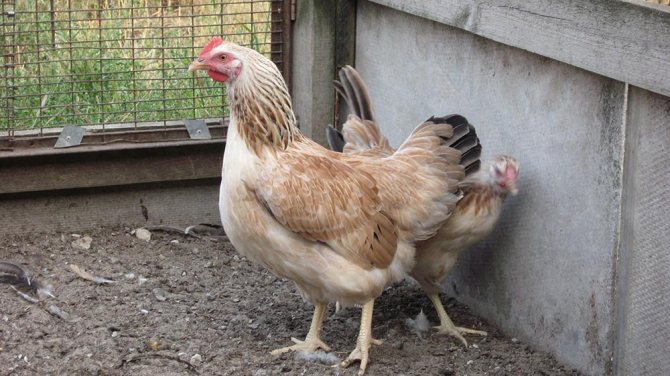

They are distinguished by endurance, resistance to diseases, strong immunity, unpretentious maintenance and nutrition. Chickens have a strong brooding instinct and can produce healthy offspring.
Chickens with such characteristics are bred in private backyards, in large farms, this is very profitable, given the excellent egg production and rapid weight gain. Eggs and meat are of excellent quality and taste good.


The only drawback to consider when organizing content is their activity and their ability to fly high. Housewives sometimes complain that chickens find the slightest opportunity to get into the garden, and then they have to plant it again. The place for walking should be well limited, maybe even arrange a mesh ceiling, because a fence without a ceiling should be much higher than two meters.
Productivity, egg production
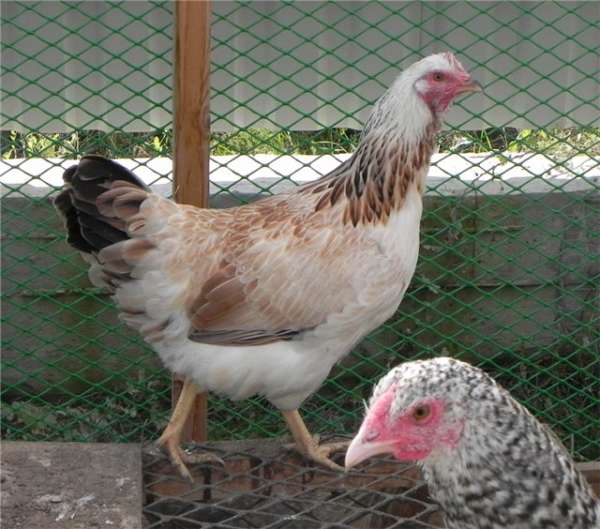

Adult laying hens bring to owners from 220 to 260 eggs per year. The eggs are large. The average is considered to be 65 g. There are also smaller ones up to 60 g. When the experts weighed the eggs, the largest turned out to be 89 g.
On average, chickens range from 2.5 to 2.7 kg, and males from 3.0 to 3.6 kg. Their meat is delicious and from 1 carcass the owner receives 1.5 kg of pulp, and sometimes more. After ripening at 5-5.5 months. chickens will begin to lay eggs, and young males will learn to trample chickens.
What is the character of the pestles?
The Zagorsk breed of salmon chickens is distinguished by a docile nature. This makes them very popular for small farms. They easily get along with each other and with people. The birds are calm, love to graze peacefully, do not quarrel among themselves and easily get along with "strangers".
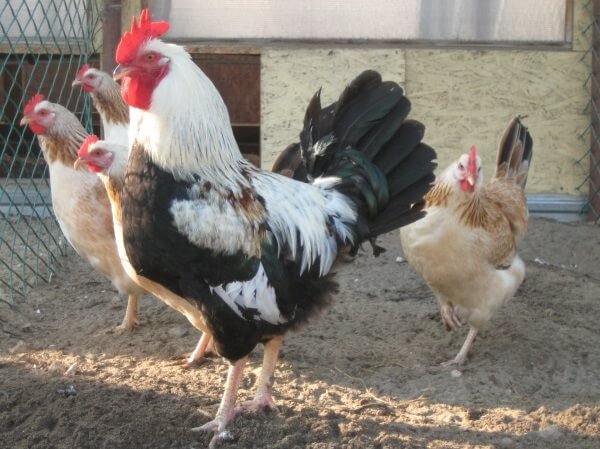

They are curious and active, and if you breed them in the household, you should protect the green spaces that can fall prey to feathered raiders.
Breeding
When the owner thinks about which hens to take eggs from, does he take into account how this or that hen meets the breed standard and how many eggs does it give? Most often, fertilized testicles are placed in an incubator and chicks are expected to appear. For laying in an incubator, eggs are taken not smaller than 55 g each, but rather more.
When chickens become overly bright, they can sit on the nests to incubate eggs, but this does not happen so often, because the owners lay eggs in the incubator. Layers are not prone to frequent nesting. They have poorly developed this instinct.
The owner for the incubator selects eggs that are larger, not smaller than 55 g. It is best to do this at 3 months. from the period when the chickens began to actively lay. Another good reference point for the owner is the molt of birds. After they change plumage, it takes 2 weeks or 1 month. and the owner can take eggs from the nests for the incubator.
The way the chicks are born is influenced by the feeding of the mothers. Therefore, before the planned selection of eggs, it is best to feed the hens excellently for a week. Add to the diet, chopped greens, vitamins, meat and bone meal.
Zagorsk salmon are used when crosses are bred. Individuals are considered the best hybrids when:
- Mother Zagorskaya salmon, and father Cornish or Kuchinsky jubilee.
- Father Zagorsk Salmon, and mother Plymouthrock or New Hampshire.
- Father, with mother Zagorsk salmon, crossed with Adler silvers.
Hybrids show rapid puberty. The birds grow large. Already at 3 months. a gutted carcass will weigh between 1.5 and 1.8 kg.
Characteristic
Zagorsk birds are active, mobile and curious birds.
- In the summer, they need long walks, during which the birds are able to find their own food on their own.
- Chickens are calm and do not show aggression towards other breeds, so they are kept in the same aviary with other birds.
- Roosters have an unfriendly disposition. Such individuals are recommended to be isolated from the herd and allowed to eat meat.
- When organizing a walk, it is worth considering that birds fly well. Given this feature, an aviary for their walking will be organized with high walls of at least 2 meters.
Feeding, with maintenance
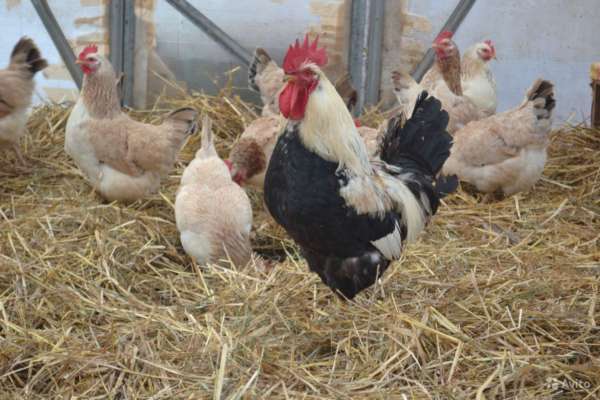

The owners note that the birds are unpretentious in keeping in the chicken coop, in nutrition. Different air temperatures are suitable for them, since they are frost-resistant. The birds are rather calm in temperament, but nimble. They tolerate stressful situations well.
In the summer, it is best to let the chickens go for a walk around the yard, site. Especially if it is planted with grass. This will help the chickens gain weight, they will have large eggs with a bright yolk. In winter, chickens are kept in chicken coops, aviaries.
If in the area where the pets live is a rather warm winter, then they do not drown in sheds with chickens and roosters. If the frosts are severe in winter, they should be kept only in a well-heated barn, otherwise, the birds will freeze and get sick.
Some may even die from hypothermia.When there is a thaw, the chickens will willingly go out into the yard and wander around it, in search of food.
With excellent nutrition, the plumage of pets is thick fluff and plumage. After molting, they quickly overgrow. Particularly beautiful salmon color in females. There are more males in this breed than females.
The owners say that chickens of this breed are distinguished by their friendliness to people and their own kind. From the Yurlovskaya breed, roosters have vociferousness.
If the owner does not want the rooster crows to wake up in the middle of the night, there is no need to disturb the bird and go into the hen house at night. At night the flock will sleep, and in the morning the roosters, like others in the village, will sing.
Birds of this breed are active. From 8 to 15 hens are left in the care of 1 rooster. For example, if hens with 30 roosters, then you need to leave 3 roosters, one will be a spare. Usually, the 2nd rooster is not allowed to the hens. This reduces the percentage of fertilized eggs.
10 chickens in the summer give 7 or 8 eggs a day. In winter, in a heated barn, with additional lighting, there will be 4 or 5. Chickens lay eggs 3 or 4 days in a row a week.
It happens that for 5 days in a row, some kind of prolific laying hen rushes, but this rarely happens. Young laying hens begin to lay eggs and after 2 months. it is clear which testicles she will give on average.
The owners say that the birds are unpretentious in their diet. Adults are given whole and crushed grain, what remains from the master's table + forage. They are also fed with compound feed, which is well balanced and useful.
If more protein is introduced into the diet of birds, for example, adding milk or yogurt, giving cottage cheese, then the layers will lay more often and the eggs will become noticeably larger. Thus, birds will respond to an increase in the amount of protein in the diet.
Good owners do not give chickens one compound feed. They introduce finely chopped greens into the diet, foods containing proteins, boil or grind vegetables into a coarse grater. They offer the bird soybean meal, throw fish waste into the mash, what is left from the master's table.
How are roosters chosen? For breeding, it is advisable to leave the largest and brightest chicks. They are placed in a separate enclosure and well fed. Such a rooster in six months will weigh from 1.8 to 2.2 kg, and a chicken 1.6 kg or more.
Salmon offspring
The birth of chickens is a joy for a mother - she can finally breathe calmly and stretch her bones after a long incubation. In this case, the birth of a new feathered generation will not bring much trouble to the owner. The crumbs have a pale yellow fluff and grow relatively quickly.
Almost all babies hatch, but, unfortunately, 10% of them die.


Here are some tips to help you keep as many chicks as possible.
- Provide a heating pad for babies to maintain optimal temperature for the first week.
- Veterinary medicine today offers a huge selection of mineral supplements and antibiotics that can improve chick survival.
- If you are new to hatching chicks, it is better to purchase ready-made food that is age-appropriate, rather than trying to satisfy the culinary needs of the little ones yourself.
- Perform an initial high-quality disinfection of the room in which you plan to grow them. Keep it clean and dry, especially in the first weeks.


Diseases and their treatment
Chickens of this breed are strong by nature. If the chickens are properly fed from 1 day of life, giving vitamins, greens and there are no sick birds on the farm, then 100% will survive. If someone dies, it will not be from illness. For diarrhea, chickens are given a weak pale pink solution of potassium permanganate.
Against parasites: lice, fleas, lice, effective ash baths. A trough full of ash is placed in the hen house and in the yard. Birds willingly bathe in it and this relieves them of parasites.
Having learned more about the breed, every villager or farmer will understand that Zagorsk salmon chickens are profitable on the farm.
One hen produces 220 to 260 eggs per year and lays an average of 3 or 4 days per week, which is very good. From 1 carcass, you can get 1.5 or 1.8 kg of meat. These are average figures, because roosters are larger than chickens. The meat of these birds is tasty and nutritious.
The cost of fertilized eggs (90 rubles) is affordable for an incubator. Everyone can look for and purchase, for example, one-day-old chickens (150 rubles one) of this breed and in the future breed these chickens on their farm. The whole family will be provided with eggs and meat.
Conditions for keeping Zagorsk salmon chickens: step-by-step instructions for building a chicken coop
Cages are not a suitable habitat for Zagorje chickens. Due to their activity and love of freedom, they do not tolerate being in a tight space. It is necessary to build a room for Zagorsk salmon chickens according to the instructions:
Step 1
Dig holes for the foundation. When calculating the area, you need to remember that 1 square meter should fall on an individual. Concrete the pits. You can erect walls in 3 weeks, when the foundation gets stronger.


Tying a columnar foundation
Step 2
Build walls with blocks, wood or brick. Since it is not necessary to install heating in the chicken coop for representatives of the Zagorsk breed, a high-quality putty and covering all holes and errors are enough. 2 meters is the optimal wall height.


For warmth, you can make high-quality wall cladding
Step 3
Make a roof with planks and slate or corrugated sheet. Make sure that there are no nails or other pointed parts on the inside of it, as birds can fly high and get injured.


Wooden roof for chicken coop
Step 4
Cover the floor with earth. It is recommended to place the boards on top to prevent birds from digging holes. Use a dense layer of sawdust and peat mixture as bedding.


Chicken coop floor
Step 5
Insert windows and install doors. Zagorsk chickens are undemanding to light, so a small window will be enough. The door must close tightly.


Windows should be small and doors should be tight
Step 6
Set up perches. It is advisable to mount them at different levels. For example, in 2 rows - at a distance of half a meter from the floor and 1.5. On the lower perches, drinkers and feeders should be placed against one wall.


Don't make big windows in the chicken coop
Step 7
Prepare the area around the chicken coop. The larger its area, the better. You can fence it off with a metal mesh. The height of the fence is at least 2 meters.
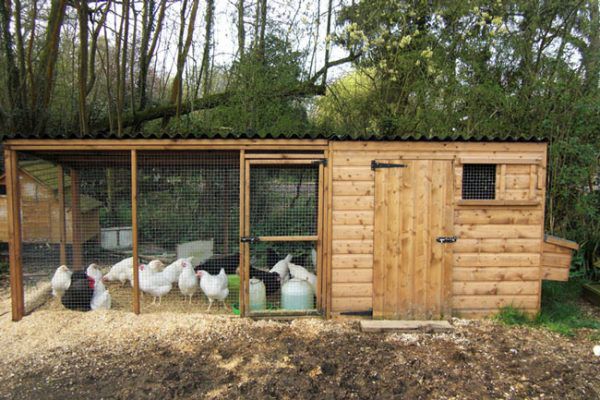

The place for walking chickens is located close to the chicken coop
Step 8
Clear the area from poisonous and thorny plants. Even if there is a drinking bowl in the chicken coop, it must be installed outside.
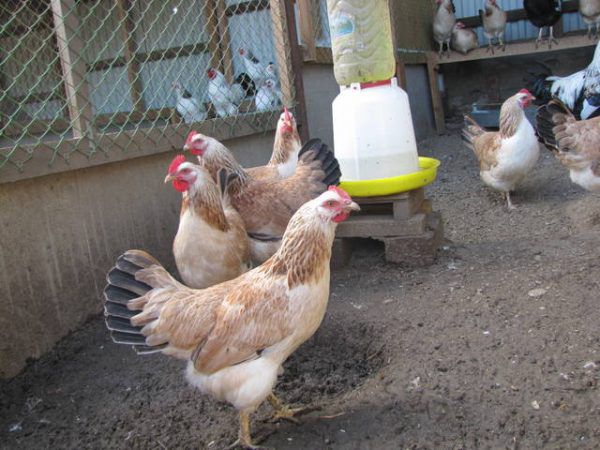

Drinking bowl for chickens in the walking area
Attention! Part of the outdoor area should be covered. Under it, chickens can hide from showers and the scorching sun. It is easy to build it from posts and slate.

